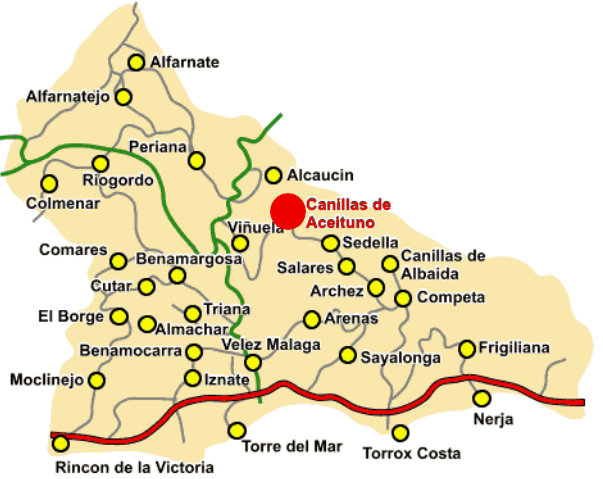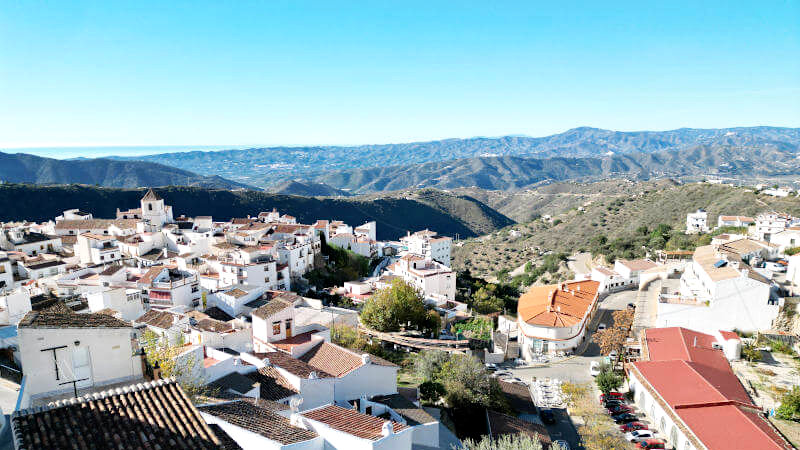-
07
Jan 2019
Canillas de Aceituno
This white mountain village is located in the east of the province of Málaga and is one of the municipalities that comprise the comarca of Axarquia and the judicial district of Vélez-Málaga. Canillas de Aceituno lies at an altitude of about 645 meters at the foot of the Sierra de Tejeda and is crowned by the top of La Maroma at 2,068 meters, the highest mountain in the province. The natural source of La Maroma attracts people from miles away because the rumor circulates that the water would be healing when drinking it. Canillas de Aceituno borders no less than 3 nature parks: Sierra de Tejeda, Sierra Almijara and the Alhama Parque Natural. From Canillas de Aceituno you look out on the spectacular reservoir of La Viñuela.
It is a village with narrow streets that are immaculately whitewashed, with ancient Moorish arches and flowers and plants in every street. The village is located 54 km from Málaga and 27 km from the coast of Torre del Mar. It is accessible via the motorway C-335 and the local M-125 from Vélez-Málaga.

Contrary to what you would think, the name of the village has nothing to do with the Spanish word for olive 'aceituna'. The name Canillas dates from the time that there was a lot of reeds here and comes from the Latin canillae (place where reeds grow). The suffix Aceituno refers to the time that the Moors produced silk here. The Arabic word for woven and dyed silk is 'azzeytun'. There are still many mulberry trees in the area, silent witnesses of silkworm production. From Canillas the only real Spanish silk route left Alcaucin and through the mountain pass of Zafarraya to the fashionable Granada, where the court of the Nasriden was located in the world famous Alhambra.
Nowadays Canillas de Aceituno lives more of the products of goat (chivo), olives, almonds and the raisins that are dried in autumn on special drying beds (paseros), decorated with rounded white stucco walls. And since a few years tourists also find their way to the village for walks to the top of the Maroma or the Saltillo, a mini Camoinito del Rey and also to enjoy a nice (goat) meal in one of the restaurants.
The geographical location of Canillas de Aceituno makes it a natural balcony of the Axarquia. The road to the village offers views of the valleys Vélez and Rubite, and goes through a landscape of olive groves, vineyards, almond and fig trees. This abundance of trees is made possible by the rivers Almanchares, Bermuza and Rubite, which also facilitate the existence of natural resources such as the Gazuela and the Ivy.
In the village itself there are two natural sources that feed an Arabic well under the town hall. One of the streets of archaeological interest is the Calle Castillo, where there are still remnants of what once was an old fortress and led to a lower district via the street Estación.
The municipality of Canillas de Aceituno has an area of 42 km2. The center lies at an altitude of 645 meters and the average annual temperature is 17°C (63°F). It has about 2,300 inhabitants called Canilleros.
Festivals
On the last Sunday in April the Canillas de Aceituno Fair is held, coinciding with the festivities of the Virgen de la Cabeza, the town's patron saint. In 1987, at the same time the town hall organized el día de la Morcilla (the Day of Black Pudding) with the objective to provide residents and visitors a typical product of the local cuisine. In the year 2004 it was declared ‘Singular Tourism Festival of the Province’.
The Black Pudding of Canillas differs from the normal one because it is made with onions and according to the traditional local recipe. Thousands of kilograms of this product will be distributed that day in the village streets, with beer and wine of the land, in a festive atmosphere that annually attracts more visitors.
The pilgrimage of San Isidro normally take place in May. The Lomilla is the place of pilgrimage of the Holy and faithful. La Virgen de la Cabeza is once again the star of the party.
Just like in almost all Andalusian villages and cities, Canillas hold their feria in the first week of August held with minimal three holidays where fun is guaranteed. The festivities are accompanied by performances and concerts among which include the Noche Flamenca, which brings together a large cast of singers and guitarists. Also sports and leisure activities have their place in these days with football and basketball singles against married, free tastings, plus a foam party for children of all ages.




